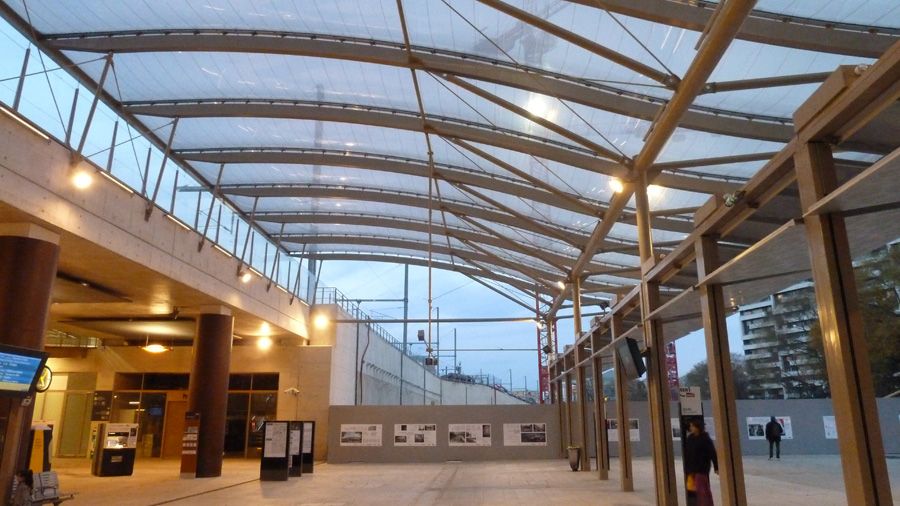
ETFE cushions are supported by a cable net system, ensuring less water retention in the event of deflation.An ATEx-certified solution. Photo: © Mathieu Hurbault - SNCF-AREP / Architects © JM Duthilleul, F. Bonnefille, E. Tricaud
The roofing of the new Rosa Parks commuter rail station on the RER E line in Paris uses ETFE-foil cushions, a light, translucent material. As part of an ATEx conducted by the CSTB, the Spanish company IASO, which specializes in fabric architecture, strengthened the soundness of this innovative system. It installed a metal cable net on the underside, which reduces the appearance of pockets of waters and ensures the stability of the supporting structure.
The architects of the Rosa Parks commuter rail station, a new RER E station in Paris between Pantin and Magenta, wanted to use inflated ETFE (ethylene tetrafluoroethylene) cushions for two roofs: the south canopy, the most technically sophisticated, and platform shelters, designed more traditionally. The company IASO, manufacturer of this innovative system, asked the CSTB to substantiate its use in this project through a Technical Experimentation Assessment (ATEx).
Water accumulation brought under control
The south canopy consists of twelve 3.5-x-20-m cushions that perfectly follow the curvature of the steel structure. During the assessment, the CSTB identified a major risk: the appearance of pockets of water when the compressor fails, causing swelling of the cushions. Composed of 300-µm upper and 200-µm lower membranes, they are unlikely to tear under the weight of the water. On the contrary, their remarkable strength poses the problem of accumulation of hundreds, or even thousands, of liters of water. This weight can cause collapse of the supporting steel structure. The wave shape of the canopy increases the risk of major stagnation of water in its lower part.
Strength and stability increased
To prevent mishaps, IASO proposed a reinforcement solution to the CSTB. It consisted of adding a network of crisscrossing cables along each cushion. This cable net does not prevent the water accumulation if there is deflation, but it decreases the scale. It facilitates water drainage while preventing the cushions from further sinking. In addition, the sizing of the structure includes the weight of accumulated water.
Testimonial
Patrick Vaillant, engineer, IASO
« The ETFE material and its installation techniques are nontraditional. Requesting an ATEx gives us an opportunity to put our design to test with CSTB experts. We’ve been working collaboratively for several years. Thanks to the five Technical Experimentation Assessments we obtained, we made it safe to use this glass canopy system. The novelty of the 2016 ATEx is the use of cables that mitigate the risk to structure stability created by major water accumulation. In addition, we continue to innovate and rely on CSTB assessments because architects are asking us for new uses of ETFE material for unique membrane facades and fabric roofs. »
Find out more:
